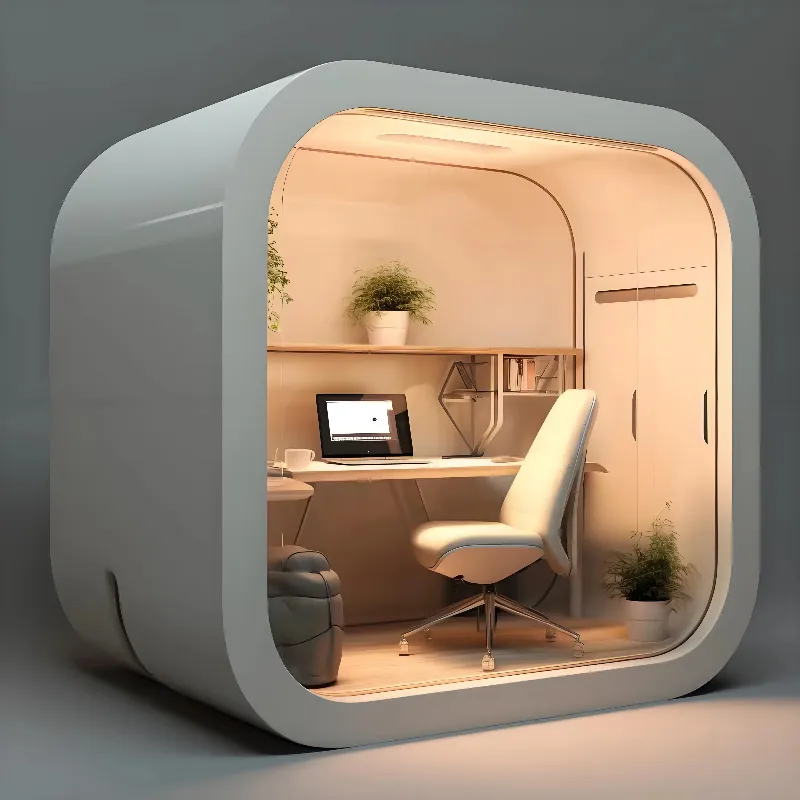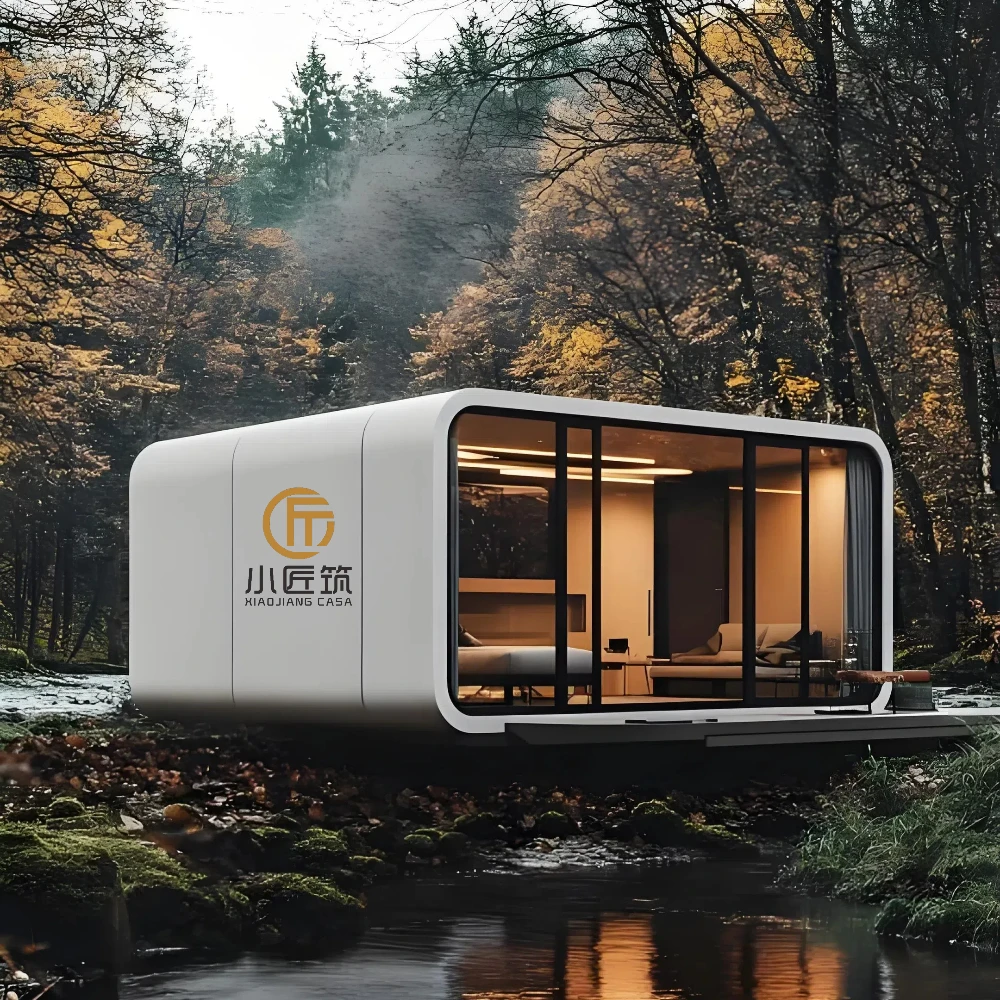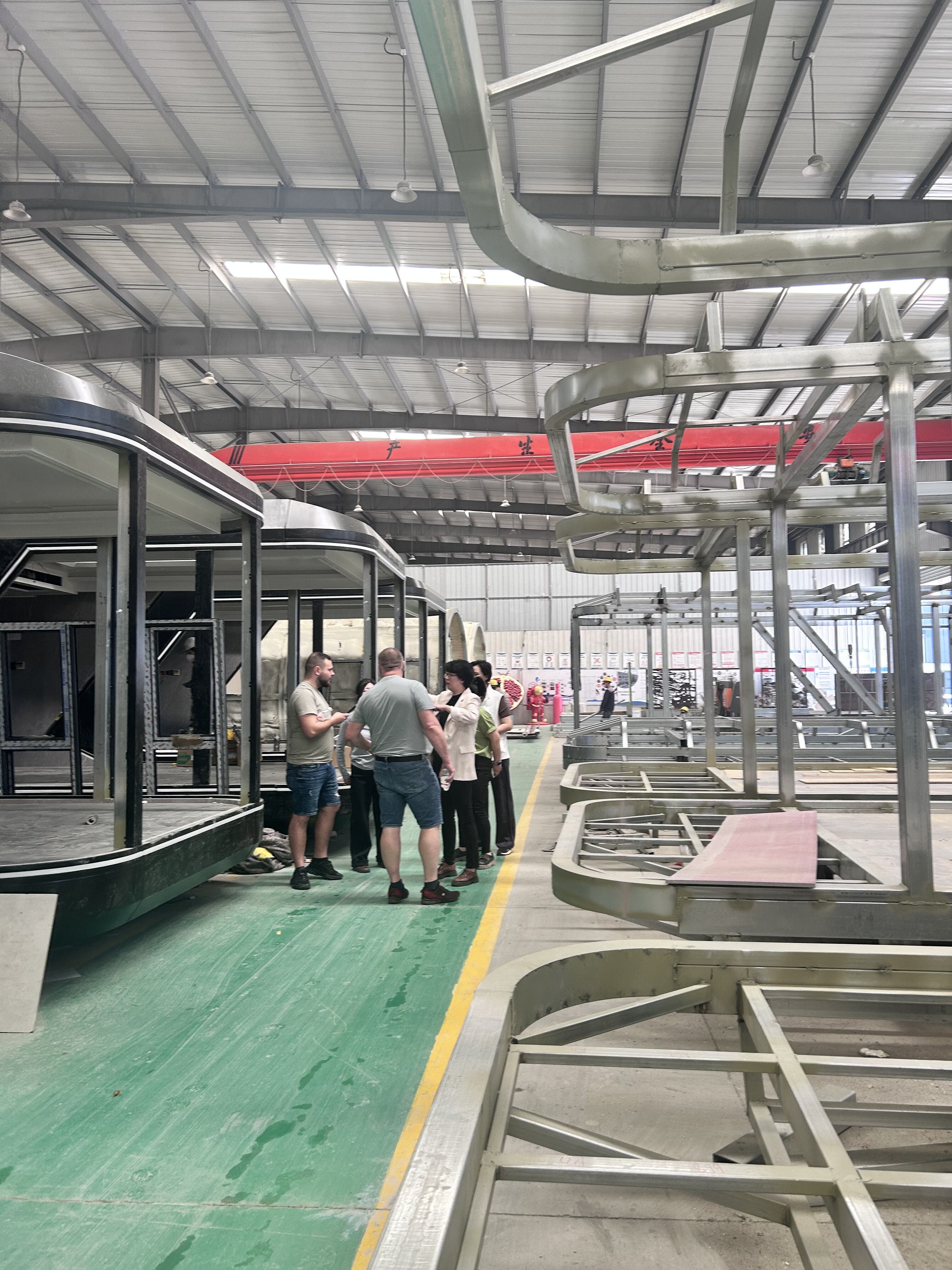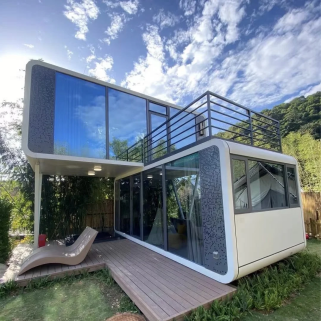Шта је кућа од контејнера и зашто постаје све популарнија?
Разумевање концепта малих кућа направљених од транспортних контејнера
Čelični transportni kontejneri, ti veliki kovčezi koje vidimo naslagane na lukama širom sveta, sada su postali prilično popularni za izgradnju stvarnih kuća. Većina ih je pri konverziji u životne prostore dugačka 20 ili 40 stopa. Ono što je počelo kao nešto što se koristi isključivo za prevoženje robe preko okeana, transformisano je kroz modifikacije poput dodavanja prozora, ugradnje odgovarajuće izolacije i povezivanja svih potrebnih komunalija kako bi ljudi mogli udobno da žive unutra. Budući da dolaze u standardnim veličinama, arhitektima se dopada rad sa ovim kontejnerima jer se mogu slagati jedan na drugi ili spajati kako bi se napravile male stambene jedinice ili čak višespratne zgrade. Neki ljudi čak grade izuzetno male kuće koristeći samo jedan kontejner, ponekad smanjujući prostor na oko 160 kvadratnih stopa, što je jedva dovoljno za bračni krevet, a kamoli još nešto.
Zašto kontejnerske kuće dobijaju na popularnosti u savremenom stanovanju?
Tri ključna faktora pokreću rastući interes:
- Ekonomska isplativost : Трошкови изградње су 20–50% нижи у односу на традиционалне куће због преработних материјала и смањене радне снаге (извештај Модуларне грађевинске асоцијације, 2023)
- Održivost : Поновном употребом једног контејнера спречава се одлагање више од 7.000 фунти челика на депонијама, што има апел на купце свесне заштите животне средине
- Dizajnerska fleksibilnost : Прилагодљиви распореди подржавају модерне, минималистичке или ванмрежне начине живота кроз прилагођиве унутрашње просторе и завршне обраде
Пораст мобилних начина становања у урбаним и руралним подручјима
Ограничења урбаних простора и трендови даљског рада потискују тражњу за преносивим становима. У градовима, стубови контејнера максимално искоришћавају ограничено земљиште; у руралним подручјима, користе се као викендице или станови за радну снагу. Агенције за хитне ситуације их такође брзо дистрибуирају – студије случаја показују да је време постављања 85% брже у односу на конвенционалне привремене смештаје.
Решења за доступније станове помоћу кућних контејнера
Упоредба трошкова: кућни контејнер насупрот изградњи традиционалне куће
Кућни контејнери нуде 57–86% предност у трошковима у односу на традиционалне изградње. Цена куће у једном контейнеру креће се од 12.000 до 35.000 долара, у поређењу са медијанском ценом станова у САД од 436.800 долара (Биро за попис САД, 2023). Ова приступачност проистиче из:
- Поново искоришћене структуре : Преработани контейнери елиминишу потребу за новим оквирима и темељним радовима
- Minimalni otpad : Прецизна израда смањује вишак материјала до 30%
Разлагање почетних инвестиција и дугорочних уштеда
Док традиционална изградња траје 6–12 месеци, куће у контейнерима обично постану настањиве за 8–12 недеља , чиме се трошкови радне снаге смањују за 30–50% (Market Research Intellect, 2024). Дугорочне предности укључују:
- Energetska efikasnost : Изоловани челични оквири смањују трошкове грејања и хлађења за 30–50% годишње
- Попусти на порезе : 22 државе нуде поврате за одрживе куће у контейнерима
Истраживање случаја из 2023. године показало је да су станови засновани на контейнерима за намирницу смањили трошкове пројекта за 62% у односу на привремене алтернативе од дрвеног оквира.
Како се транспортни контејнери смањују трошкови материјала и радне снаге
Предивидиване челичне модуле заобилазе одгађања у набавци материјала, користећи 85% преработаног челика по јединици. Поновном употребом отписаних контејнера:
- Материјални трошкови смањују се до 60%, избегавајући бетон, опеку и дрвену грађу
- Рокови за радну снагу се значајно скраћују због поједностављене изградње на терену
Овај модел подржава развој који се може проширити и одржив је, истовремено решавајући недостатак станова. Сазнајте како економски исплатива решења за модуларне станове мењају урбани планинг.
Портабилност и предности брзе изградње
Брзи временски оквир изградње: од дизајна до настањења у току неколико недеља
Кућни контейнери скраћују дуге графиконе изградње на неколико недеља. Јединице стижу унапред опремљене електричним системима, инсталацијама водовода и изолацијом, што омогућава екипама да се фокусирају на завршну интеграцију, а не на изградњу од основе. Према анализи индустрије (Satellite Industries, 2023), модуларне методе смањују време изградње за 40–50% .
| Metrički | Kućne kontejnere | Tradicionalna izgradnja |
|---|---|---|
| Просечно време изградње | 6–12 недеља | 6–18 mjeseci |
| Зависност од временских прилика | Minimalno | Visok |
| Troškovi rada | 20–35% нижа | Променљива, зависна од локације |
Краћи рокови смањују трошкове финансирања и убрзавају повратак инвестиције – посебно важно за послове изнајмљивања, школе и операције хитних служби.
Портабилност као кључна предност за привремени или удаљени смештај
Могућност премештања кућних контейнера задовољава критичне потребе у различитим секторима:
- Рударство/Енергетика : Станови за раднике на удаљеним нафтним пољима или рудницима
- Događaji : Привремени трговачки објекти или смештај на фестивалима
- Obrazovanje : Брзо постављиве учионице приликом проширења
За разлику од сталних конструкција, ови објекти задржавају 85–90% продајне вредности након пресељења (Ponemon, 2023). Челични оквiri издржавају вишеструка померања, а опциони точкови на шасији олакшавају транспорт.
Студија случаја: Смештај за жртве катастрофа коришћењем готових контейнерских јединица
Након што је ураган Лаура 2020. године расељио 10.000 становника Луизијане, федерална агенција је у року од 17 дана дистрибуирала 120 модификованих кућних контјенера као привремене склоништа. Сваки објекат је имао:
- Соларне ХВАЦ системе
- Raspored koji odgovara ADA
- Unutrašnji završni slojevi otporni na pljesan
Nakon krize, 70% je ponovo korišćeno kao stambeni prostor za radnu snagu, što pokazuje dvostruku funkcionalnost pokretnih dizajna.
Fleksibilnost dizajna i mogućnosti prilagođavanja za kuće od kontejnera
Potpuno prilagodljive rasporedne rešenja za moderno, minimalističko ili vanmrežno stanovanje
Kuće od transportnih kontejnera su izuzetno svestrane – zaista. Odlično funkcionišu za otvorene rasporede prostora, male studijske prostorije, pa čak i za potpuno opremljene porodične kuće kada je to potrebno. Modularna struktura omogućava ljudima da ih postave jedan pored drugog ili nanizuju jedan na drugi. Uzmite osnovni kontejner površine 160 kvadratnih stopa? Pametnim nanizivanjem postaje lepa malena kuća od 640 kvadratnih stopa sa dva sprata. Poslednje tendencije u izvedbi pokazuju i zanimljive kombinacije. Mnogi vlasnici mešaju sirov industrijski izgled sa čistim minimalističkim elementima. Neki pametni dizajni uključuju zidove koji se sklapaju kada nisu u upotrebi i kompaktne stepenice koje štede dragoceni prostor, a pri tom ne izazivaju osećaj tesnoće.
Иновативни архитектонски дизајни који трансформишу једно- и вишеконтejнерске куће
Данас архитекте више не гледају на транспортне контейнере само као на складишта, већ као на стварне градитељске елементе за креативне конструкције. Варећи и обликујући ове металне кутије, праве се разнолики интересантни дизајни – од замршених кривина до драматичних конзолних решења и комплексних геометријских форми. Системи проширивих контјинера заправо омогућавају око 35 процената више жivotнog простора у поређењу са обичним нагомиланим распоредима, а истовремено задржавају фактор покретности. Нека веома паметна решења повезују четири до шест контјинера у облику тркачке звезде. Овај распоред централно смешта све неопходне инсталације, док су приватни спаваћи простори распоређени око заједничких површина намењених окупљању и друштву.
Унутрашња и спољашња завршна обрада која подиже естетску и функционалну вредност
| Елемент дизајна | Опције персонализације |
|---|---|
| Spolja | Браздана метална плоча за индустријски стил, дрвене ламперије за топлоту или рефлектујући преклопи за смањење топлоте |
| Unutra | Podovi od bambusa, akustični zidni paneli, obradjeno betonske površine |
Održivi nadogradnji poput krovova pripremljenih za solarnu energiju i zelenih zidova sada su uključeni u 72% pojedinačnih izgradnji (Izveštaj o modulnim kućama 2024), što povećava izdržljivost i omogućava besprekornu integraciju sa prirodnim okruženjem.
Održivost, izazovi i budućnost življenja u kontejnerskim kućama
Reciklaža čeličnih kontejnera radi smanjenja građevinskog otpada
Када се стари транспортни контејнери поново искористе уместо да се одбаце, спречавамо огромне количине челика да заврше на депонијама сваке године. Узмимо, на пример, један стандардни 40-флсни контејнер — он спречава око 3.500 килограма старог металног отпада да се накупи негде. То је заправо прилично много, ако размислите о томе — иста количина која је потребна за конструкцију обичне куће површине две хиљаде квадратних стопа. Цела идеја поновне употребе ових контејнера има пуно смисла, јер значи да нам треба око четвртине до трећине мање нових грађевинских материјала. Мања потражња преводи се у мању рударску активност и значајно ниже емисије угљеника из производње челика која се дешава у позадини.
Енергетска ефикасност и интеграција соларних панела и зелених кровова
Савремене куће направљене од контејнера постижу уштеду енергије од 40–60% кроз стратешке надоградње:
| Karakteristika | Допринос уштеди енергије |
|---|---|
| Соларни панели | 50–70% укупних потреба за струјом |
| Зелени кровови | побољшање ефикасности грејања и хлађења за 15–30% |
| Изолација високих перформанси | 25% смањен пренос топлоте |
Уз интегрисане обновљиве изворе, многи пројекти постижу нулте емисије или потпуно енергетско независне.
Структурне измене, изолација и прописи
Упркос унутрашњој чврстоћи, 68% кућа од контејнера захтева додатно инжењерство за:
- Изолацију прилагођену клими (нпр. пену за прскање у хладнијим подручјима)
- Прилагођавање носивости за слагање
- Усклађеност са регионалним прописима о оптерећењу ветром и снегом
Дозволе су упрошћене у 22 америчке државе, мада 45% градитеља сусреће проблеме са зонирањем у урбаним подручјима због естетских разлога.
Будућност мобилног живота: трендови у мини кућама, паметним технологијама и растућем потражњом
Очекује се да ће глобални тржиште кућа од контејнера расти стопом од 6,8% годишње до 2030. године, подстакнуто:
- Паметне мали куће : системи за климатску контролу и мобилност са ИоТ технологијом
- Заједнице отпорне на катастрофе : села од контейнера за брзу имплементацију
- Урбани пројекти попуњавања : 58% архитеката сада сматра да су контейнери прикладни за намирну стамбену изградњу високе густине
Ова промена усклађена је са вредностима млађих генерација – 63% Зумера и милинијалаља ставља акценат на одрживост, а не на површину квадратних метара, приликом куповине куће (Национална стамбена истраживање 2024).
Често постављана питања
Шта је кућа од контейнера?
Кућа од контейнера је становни објекат направљен од транспортних контјенера, који су уобичајено дуги 20 до 40 стопа. Ови контјенери се модификују додавањем основних удобности како би се створили станбени простори.
Зашто су куће од контјенера јефтиније од традиционалних кућа?
Куће од контејнера су јеftиније због употребе рециклираних материјала, смањених трошкова радне снаге и отпадања потребе за новим оквирима и темељним радовима.
Да ли су куће од контејнера одрживе?
Да, одрживе су јер поново користе старе транспортне контејнере, смањују отпад челика и смањују потражњу за новим грађевинским материјалима.
Колико брзо се може изградити кућа од контејнера?
Куће од контејнера се обично могу изградити за 8–12 недеља, што је значајно брже у односу на традиционалну изградњу кућа, која може потрајати 6–18 месеци.
Које су неке примене преносивих кућа од контејнера?
Преносиве куће од контејнера могу се користити за становање радника у удаљеним подручјима, привремене продавнице, смештај на фестивалима и брзо постављиве учионице, као и друге примене.
Да ли куће од контејнера захтевају додатну изолацију?
Да, многе куће од контејнера захтевају изолацију прилагођену клими и могу имати потребу за додатним инжењерским решењима за носивост и прописану усклађеност, нарочито када су сложене једна на другу.
Садржај
- Шта је кућа од контејнера и зашто постаје све популарнија?
- Решења за доступније станове помоћу кућних контејнера
- Портабилност и предности брзе изградње
- Брзи временски оквир изградње: од дизајна до настањења у току неколико недеља
- Портабилност као кључна предност за привремени или удаљени смештај
- Студија случаја: Смештај за жртве катастрофа коришћењем готових контейнерских јединица
- Fleksibilnost dizajna i mogućnosti prilagođavanja za kuće od kontejnera
- Održivost, izazovi i budućnost življenja u kontejnerskim kućama
- Често постављана питања








